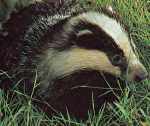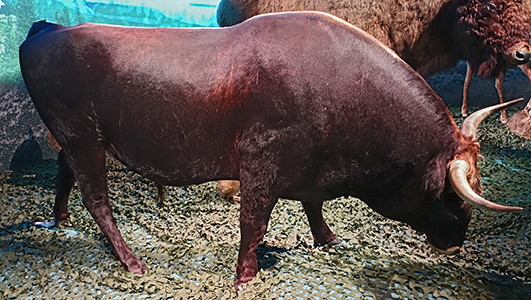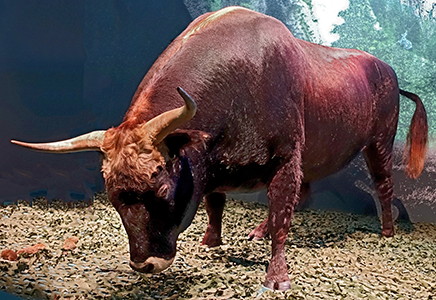Back to Don's Maps
Ice Age Animals
As the last great ice age (the fourth, or Wurm) began, the advancing ice of the Wurm glaciation forced tundra animals further south into western europe. The increasingly cold conditions altered the vegetation as well. The spruce, fir, and arctic willow were now found only in the more sheltered river valleys, while the rest of the landscape was mostly deforested.

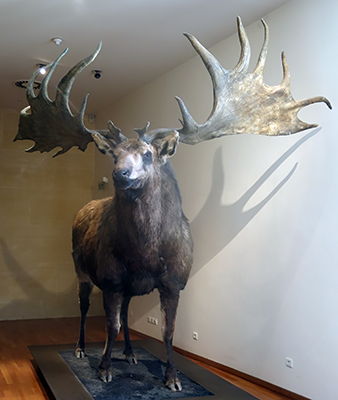
Megaloceros (listed on the display as Mégacéros) were important herbivores in Eurasia during the Ice Ages. The largest species, M. giganteus, vernacularly known as the "Irish Elk" or "Giant elk", is also the best known.
Most members of the genus were extremely large animals that favored meadows or open woodlands, with most species averaging slightly below 2 metres at the withers.
Text: Adapted from Wikipedia
Photo: Don Hitchcock 2008
Source: Display at Le Musée National de Préhistoire, Les Eyzies-de-Tayac
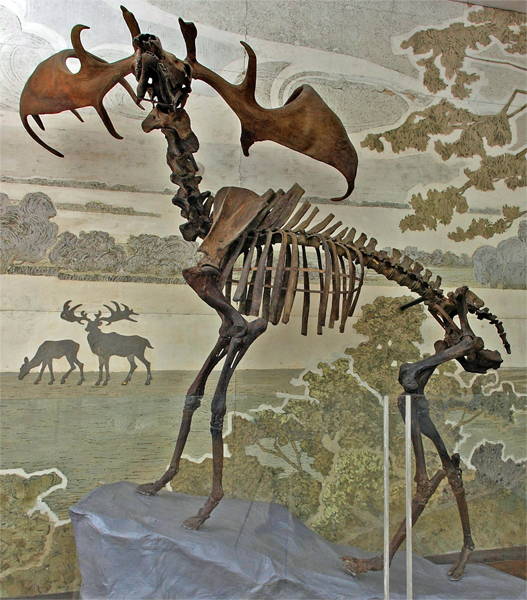
Megaloceros Skeleton. Note the processes on the vertebrae near the neck to provide support for the muscles and tendons which hold up the neck and head.
Photo: http://xn--c1ackcnvhn3h0a.xn--p1ai/5874#
Going the way of the dodo?
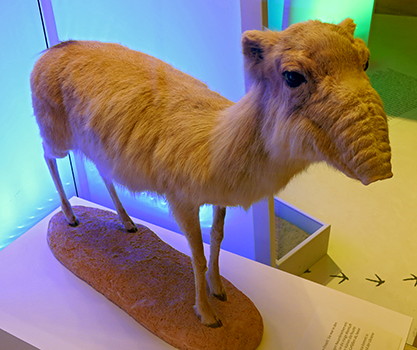
Saiga antilope
The Saiga was one of the most distinctive animals of the last Ice Age. It was widespread in the cold steppes of Eurasia.
The voluminous nose with large womb-shaped nasal bones contains strongly perfused mucous membranes. Thus in winter it can warm up the icy breath of the Eurasian steppes. In the summer, the moist-cold nasal mucous membranes cool the blood in the blood vessels before it enters the brain.
Today there are only two subspecies: the Saiga tatarica tatarica occurs in parts of Russia, Kazakhstan, Chi na, Turkmenistan, Uzbekistan and Ukraine and the Saiga tatarica mongolica lives in Mongolia.
Photo: Don Hitchcock 2015
Source: LVR-Landesmuseum Bonn, Germany
On loan: Zoologisches Forschungsmuseum Alexander Koenig, Bonn
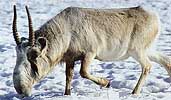 From: New Scientist, 15 February 2003. This is an excellent magazine, and well worth subscribing to.
From: New Scientist, 15 February 2003. This is an excellent magazine, and well worth subscribing to.
In a bid to save the rhino, conservationists suggested using saiga horn instead of rhino horn in traditional medicines. Their plan has backfired as hunters run amok
By Fred Pearce
An antelope that just a decade ago crammed the steppes of central Asia is this spring on the verge of extinction, victim of an epidemic of poaching. Biologists say it is the most sudden and dramatic population crash of a large mammal ever seen.
In 1993, over a million saiga antelopes roamed the steppes of Russia and Kazakhstan. Today, fewer than 30,ooo remain, most of them females. So many males have been shot for their horns, which are exported to China to be used in traditional fever cures, that the antelope may not be able to recover unaided.
The slaughter is embarrassing for conservationists. In the early 199os, groups such as WWF actively encouraged the saiga hunt, promoting its horn as an alternative to the horn of the endangered rhino.
Saiga (Saiga tatarica) once dominated the open steppes from Ukraine to Mongolia. They have always been hunted for meat, horns and skins. However, even in Soviet times, hunters killed tens of thousands each year, without dramatically lowering the population.
But since the collapse of the Soviet Union, a lucrative market in the horns has opened up, with hunters using motorcycles and highpowered weapons to chase and kill their quarry. In China, saiga horns fetch around $100 a kilogram. Organised gangs illegally export the horn by train from Moscow to Beijing, or across the border from Kazakhstan.
"The plains used to be black with these antelopes, but now you can go out there and not see any at all," says Abigail Entwistle, a zoologist from Flora and Fauna International, a British-based charity. "This is the most sudden change in fortune for a large mammal species recorded in recent times." The closest comparison may be with the African elephant, which faced a similar poaching frenzy in the 1980s, causing its numbers to fall from a million to half a million in a decade. But the saiga's numbers, which started at a similar level, have fallen by 97 per cent.
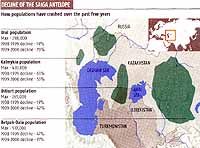 The scale of the slaughter, and its almost total destruction of the male saiga, has overwhelmed the animals' famed fecundity "We don't know of any case in biology where the sex ratio has gone so wrong that fecundity has crashed in this way," says Eleanor Milner-Gulland of Imperial College, London, the leading expert in the West on the species.
The scale of the slaughter, and its almost total destruction of the male saiga, has overwhelmed the animals' famed fecundity "We don't know of any case in biology where the sex ratio has gone so wrong that fecundity has crashed in this way," says Eleanor Milner-Gulland of Imperial College, London, the leading expert in the West on the species.
Between 1993 and 1998, saiga numbers across central Asia almost halved, to around 600 000. Then, with most of the males gone, the population crash began in earnest, says Milner-Gulland. Numbers have halved each year since, until last year's census recorded just 30 000 individuals. There is, she says, no sign that the crash is due to disease or unusual weather.
One of the most critically endangered herds is in the huge Betpak-Dala region in central Kazakhstan, where in 1993 more than half a million saiga lived. By last year their numbers had crashed to just 4000 - a 99 per cent drop from which there may be no return. Aerial surveys last year by the Institute of Zoology in Kazakhstan revealed no adult or juvenile males, only females, says Milner-Gulland. And time is running out to bring extra males in, as saiga antelopes normally only live for three to four years.
Conservationists have struggled to keep up with the scale of the disaster, and did not put the saiga on the Red List of critically endangered species until October 2002. In the coming months they will launch an emergency appeal to rescue wild herds. "We think we have probably got just two years to save the species," says Entwistle. "The trouble is, most people have never heard of the animal, so it is hard to raise funds."
It is unlikely that hunters will drive the saiga to total extinction, as they did the dodo, quagga. and passenger pigeon. But without a dramatic reversal of its fortunes, it will soon be confined to zoos and a few small reserves.
A decade ago, the saiga antelope seemed so secure that conservationists fighting to save the rhino from poaching suggested using saiga horn in traditional Chinese medicines as a substitute for rhino horn.
Research commissioned by WWF at the Chinese University of Hong Kong in the late 1980s found it to be as effective as rhino horn in fighting fevers, and in 1991 WWF began a campaign in Hong Kong to publicise it as an alternative. The following year, the UN Environment Programme appointed WWF ecologist Esmond Bradley Martin as its "special envoy" to persuade pharmacists across Asia to adopt saiga horn (New Scientist, 9 March 1991, p 15, and 3 October 1992, p 10).
But the saiga had died out in China in the 1960s, and the resulting upsurge in demand opened the floodgates to unregulated imports. By 1993, says Milner-Gulland, "Hong Kong markets were piled high with saiga horn" from Kazakhstan and Russia. The slaughter had begun.
Bradley Martin is unapologetic. He told New Scientist: "I supported the use of saiga antelope horn as a substitute for rhino horn from the early 198os. In my opinion it was the correct policy at the time. But I stopped around 1995, when I read about the start of the sharp decline in saiga populations."
 The ptarmigan becomes very hard to see in winter
against a backdrop of snow. Even its feet are covered in feathers.
Despite all these efforts at camouflage, the ptarmigan is a loud bird.
Its noises resemble the sounds bullfrogs make.
The ptarmigan becomes very hard to see in winter
against a backdrop of snow. Even its feet are covered in feathers.
Despite all these efforts at camouflage, the ptarmigan is a loud bird.
Its noises resemble the sounds bullfrogs make.
Photo: Kalman, B. 'Arctic Animals'
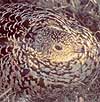
When the female ptarmigan sits on her nest, its summer
colouring blends with its nesting place. The ptarmigan is completely covered by warm feathers. Even its nostrils
and feet are feathered to provide protection from the cold. The plumage
on its feet also makes the ptarmigan's feet wider. Wide feet spread its
weight more evenly so it can walk on soft snow without sinking. These
feet feathers are, not surprisingly, called snowshoe feathers!
Photo: Kalman, B. 'Arctic Animals'
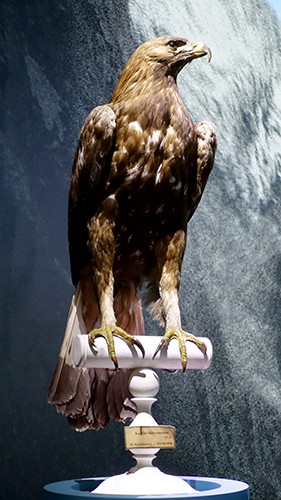
Golden Eagle, Aquila chrysaetos
The golden eagle (Aquila chrysaetos) is one of the best-known birds of prey in the Northern Hemisphere. It is the most widely distributed species of eagle. These birds are dark brown, with lighter golden-brown plumage on their napes. Golden eagles use their agility and speed combined with powerful feet and massive, sharp talons to snatch up a variety of prey, mainly hares, rabbits, marmots and other ground squirrels.
Golden eagles maintain home ranges or territories that may be as large as 200 km2 (77 sq mi). They build large nests in cliffs and other high places to which they may return for several breeding years. Most breeding activities take place in the spring; they are monogamous and may remain together for several years or possibly for life. Females lay up to four eggs, and then incubate them for six weeks. Typically, one or two young survive to fledge in about three months. These juvenile golden eagles usually attain full independence in the fall, after which they wander widely until establishing a territory for themselves in four to five years.
Once widespread across the northern parts of the northern hemisphere, it has disappeared from many areas which are now more heavily populated by humans. Despite being now uncommon in some of its former range, the species is still widespread, being present in sizeable stretches of Eurasia, North America, and parts of North Africa.
Photo: Don Hitchcock 2018
Source: Reconstruction, Musée de l'Homme, Paris
Text: Wikipedia

Caribou
Photo: Kalman, B. 'Arctic Animals'
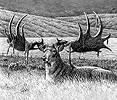 Megaloceros, a giant deer, was just over 2m (6ft 6in) at the shoulder, about the size of a moose.
Megaloceros, a giant deer, was just over 2m (6ft 6in) at the shoulder, about the size of a moose.
The antlers together span about 3.6m (12ft), or 1.8m (6ft) each. Some were even larger.
Cave paintings often seem to indicate a colour pattern for Megaloceros with a brownish back, a creamy chest and dark markings around the neck and shoulders. Although 'Irish Elk' is a common name used for Megaloceros, it is a deer, rather than an elk (most closely related to the Fallow deer). Also it is not just found in Ireland, but all across Europe. Thus, Megaloceros (meaning 'giant antler') is a better name for it.
The large numbers of skeletons from the peat bogs of Ireland have revealed that many male Megaloceros died from malnutrition and exhaustion during the winter. This is probably due to the rigours of the autumn rutting season, which many European deer have, during which males do not eat, and fight for the right to mate with a harem of females.
Photo: http://dsc.discovery.com/convergence/landofmammoth/eyecandy/main.html
Text: Adapted from http://www.bbc.co.uk/beasts/evidence/prog6/page3_2.shtml
 Photo: Kalman, B. 'Arctic Animals'
Photo: Kalman, B. 'Arctic Animals'
Arctic Wolf
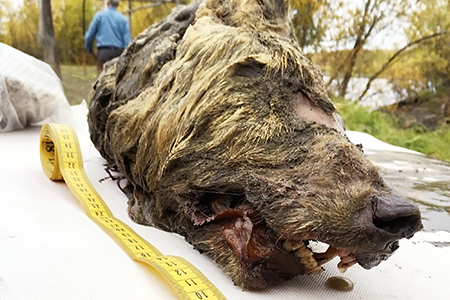
Siberian wolf, 40 000 BP.
Still covered in thick fur and sporting a vicious-looking set of fangs, the 38-centimetre-long head was found on the Tirekhtyakh river in the remote Siberian region of Yakutia by locals hunting for mammoth tusks last year.
Photo: Dr Albert Protopopov, The Siberian Times
Source and text: Alec Luhn, https://www.smh.com.au/environment/sustainability/prehistoric-wolf-head-found-as-siberian-permafrost-thaws-20190612-p51wvo.html
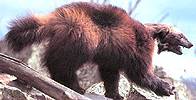
The wolverine has been called a glutton, a trouble-maker, and a
ferocious predator. Some people even believe that it is the animal
behind the abominable snowman legends. A cloud of mystery surrounds the
wolverine because this animal likes to be alone and is rarely seen by
people. Recent studies have shown that the wolverine does not gorge
itself on food and is not any more ferocious than an angry red
squirrel.
Mating season is the only time of year that wolverines get together.
Once mating has occurred, couples go their separate ways. Several
months later mother wolverines make dens in rocky caves or beneath the
roots of fallen trees. In March or April they have from two to five
cubs. Wolverines do not breed until they are four years old. Most other
arctic animals mate and have young long before this because they mature
more rapidly than wolverines. Maturing late may account for the low
wolverine population.
The wolverine is the largest member of the weasel family and, like
other weasels, it is an omnivore that feeds on a variety of animal and
plant foods. In summer it eats blueberries, ground squirrels, and
birds' eggs. In winter it hunts small animals but spends most of its
time as a scavenger, feeding on the carcasses of caribou, seals, and
even whales.
The wolverine is known for its big feet and loping gait. As it runs,
its four furry feet hit the ground all at once. These furry feet tend
to slow the animal down in the summer, but they are a great advantage
in the winter. When the wolverine chases a caribou, moose, or other
large animal in the deep snow, it can move quickly, whereas the prey
exhausts itself. Thanks to its snowshoe feet, the wolverine is able to
bound along on top of the snow and kill stranded animals.
Photo and text: Kalman, B. 'Arctic Animals'

The "sabretoothed tiger," Smilodon, is the second most common fossil mammal found in the La Brea tar pits. The first Chairman of the University of California Department of Paleontology, Professor John C. Merriam , and his student Chester Stock, monographed the morphology of this great carnivore in 1932. Since then, hundreds of thousands of Smilodon bones have been found at La Brea. These finds have permitted remarkably detailed reconstructions of how Smilodon lived. We now know Smilodon was about a foot shorter than living lions but was nearly twice as heavy. Also, unlike cheetahs and lions (which have long tails that help provide balance when the animals run) Smilodon had a bobtail. These suggest that Smilodon did not chase down prey animals over long distances as lions, leopards, and cheetahs do. Instead, it probably charged from ambush, waiting for its prey to come close before attacking.
Photo: http://igs.indiana.edu/FossilsAndTime/Sabertooth.cfm
Text: http://www.ucmp.berkeley.edu/mammal/carnivora/sabretooth.html
Smilodon is a relatively recent sabretooth, from the Late Pleistocene . It went extinct about 10 000 years ago. Fossils have been found all over North America and Europe. Smilodon fossils from the La Brea tar pits include bones that show evidence of serious crushing or fracture injuries, or crippling arthritis and other degenerative diseases. Such problems would have been debilitating for the wounded animals. Yet many of these bones show extensive healing and regrowth indicating that even crippled animals survived for some time after their injuries. How did they survive? It seems most likely that they were cared for, or at least allowed to feed, by other sabretoothed cats. Solitary hunters with crippling injuries would not be expected to live long enough for the bones to heal. Smilodon appears to have lived in packs and had a social structure like modern lions. They were unlike tigers and all other living cats, which are solitary hunters. Occasional finds of sabretooth tooth sized holes in Smilodon bones suggest the social life of Smilodon was not always peaceful. The cats may have fought over food or mates as lions do today. Such fights were probably accompanied by loud roaring. From the structure of the hyoid bones in the throat of Smilodon, we know it could roar.
Text above: http://www.ucmp.berkeley.edu/mammal/carnivora/sabretooth.html
The Ermine
 The ermine is another member of the weasel family. In the summer its long, lean body is covered in a
coat of short dark brown fur. In the winter its coat turns to a snowy
white color except for the black tip on its tail. In the past ermine
furs and tails decorated the robes of royalty. Today ermines are still
bred so that their pelts can be used to make coats. Ermine farmers of
the Siberian Arctic make a good living raising these animals for their
pelts.
The ermine is another member of the weasel family. In the summer its long, lean body is covered in a
coat of short dark brown fur. In the winter its coat turns to a snowy
white color except for the black tip on its tail. In the past ermine
furs and tails decorated the robes of royalty. Today ermines are still
bred so that their pelts can be used to make coats. Ermine farmers of
the Siberian Arctic make a good living raising these animals for their
pelts.
Ermines make their homes in underground holes that have been dug out by
other burrowing animals. Mother ermines make a cozy nursery lined with
the fur from other animals. Their young grow quickly and are able to
have families of their own in less than a year!
The ermine is an efficient hunter that preys on other small animals and
birds. Its excellent sense of smell allows it to expertly sniff out its
prey during the dark arctic nights. When killing its prey, the ermine
pounces on it and bites it at the back of the neck. It then wraps its
snakelike body around the victim to ensure that it cannot escape.
Photo and text: Kalman, B. 'Arctic Animals'

The European Red Fox
Photo: Bottoni L. et al, 'Central Europe'
With its 27-inch (70 cm) length and 22 to 44 pounds (10 to 20 kg) of weight, the badger is certainly the most unusual animal of its family (which includes mink, weasels, ferrets, and martens). Besides its stocky body, another feature of the badger is its way of walking like a bear. it has some social behavior, but each badger sharing a den lives in a manner that is independent of the others. it makes a variety of sounds such as puffing noises, moans, bellows, growls, and long yells, although they are rarely heard by people.
Although they are all carnivores, their diets include large amounts of insects and plants.
The badger, a stocky animal with a black-and-white snout is primarily a vegetarian. However, it also eats bird eggs, young birds, small hares, and above all, rodents. It lives throughout Europe. The badger lives alone in dens at the edges of forests. The den is made in dry earth and has a main room, or chamber, that is generally 3 to 6 feet (1 to 2 m) deep. Many tunnels branch off from it leading to entrances at the surface that are at least 33 feet (10 m) from each other.
The badger leaves its den only at night to search for food. In the winter, although it does not hibernate, the badger sleeps for long periods. It wakes up from time to time to leave the den to search for food. During the mating season, which occurs in summer, the male and female live together. After mating, the embryo does not begin to develop for four to five months. In February, the female gives birth to three to five young. It nurses and cares for them until the next autumn.

The Pine Marten is an agile climber and is able to prey on squirrels and birds.
Photo: Bottoni L. et al, 'Central Europe'
 The Otter
The Otter
This aquatic mammal has become quite rare in Europe. It lives in areas near fairly deep streams and lakes that have abundant vegetation. The otter has several mechanisms that enable it to live on both land and water. The eyes and nostrils are located toward the top of the head. The skull is flattened and the feet are webbed. When swimming, the legs are held against the body and the animal is propelled forward by a wavelike movement of the body. The tail also helps this movement and it also functions as a rudder.
When the otter is underwater, the nostrils and ears are closed and the muscles of the eyes adjust the eye lens so that the otter can see better. At night or in cloudy water, its vision is assisted by the sensitive whiskers of the snout Its coat has long, thick fur that is waterproofed by oils produced by the skin. In the water, the fur flattens and offers little resistance. The fluffy hairs near the skin remain dry, and the air trapped by them acts as an insulating layer.
The otter feeds mostly on fish and sometimes on aquatic birds, water voles, and nutrias (aquatic rodents that resemble beavers). It is an expert hunter. It can swim faster than fish, so it can follow them for long distances. It may wait for them under a rock or surprise them with a lightning fast dive.
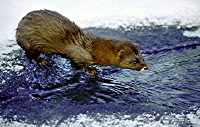
The European mink, foraging in an ice
edged stream
Photo:
http://zoology.nsys.by:8101/eminks/mink.html
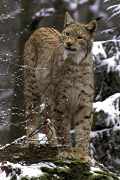
The European
lynx
Photo:
http://lynx.uio.no/jon/lynx/eulynx1.htm
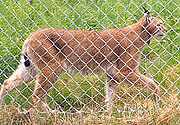
The European lynx in a
nature park in northern Norway.
Photo: Per,
2001
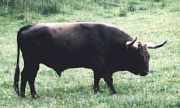 The aurochs is the ancestor of domestic cattle. It
became extinct at the beginning of the seventeenth century. The aurochs
probably evolved from an ancestor that also lived in Asia Minor and
North Africa. Evidence for this comes from drawings and paintings of an
animal similar to the aurochs from ancient Egyptian and Assyrian
sculptures. This animal was also mentioned in the Bible as "Re-em." The
last written proof of the aurochs' existence comes from a document
written by the Baron of Herbestein during 1513-1533. Under a drawing of
the animal he wrote: 'I am the aurochs, called Thur by the Poles, Aurox
by the Germans, and sometimes even bison by the ignorant.'
The aurochs is the ancestor of domestic cattle. It
became extinct at the beginning of the seventeenth century. The aurochs
probably evolved from an ancestor that also lived in Asia Minor and
North Africa. Evidence for this comes from drawings and paintings of an
animal similar to the aurochs from ancient Egyptian and Assyrian
sculptures. This animal was also mentioned in the Bible as "Re-em." The
last written proof of the aurochs' existence comes from a document
written by the Baron of Herbestein during 1513-1533. Under a drawing of
the animal he wrote: 'I am the aurochs, called Thur by the Poles, Aurox
by the Germans, and sometimes even bison by the ignorant.'
Photo:
http://www.aristotle.net/~swarmack/aurochs.html
Text: Bottoni et al, 'Central Europe'
Aurochs.
Photo: Don Hitchcock 2018
Source: Reconstruction, Musée de l'Homme, Paris
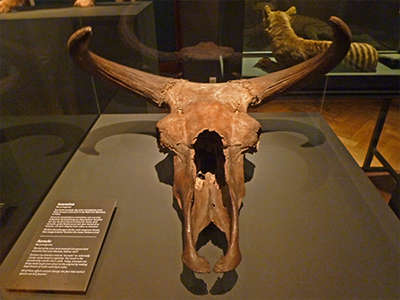
Aurochs skull, Bos primigenius
The last of the once most powerful European land mammal died near Warsaw, Poland, in 1627.
German zoo directors tried to 'recreate' an externally similar cattle breed in captivity. The result is the considerably smaller Heck cattle. Today, attempts are being made to get even closer to the original by mating large breeds of cattle with Heck cattle.
All of these efforts cannot change the fact that extinct species are lost forever.
Photo: Ralph Frenken 2013
Source and text: Museum of Natural History, Vienna, Austria
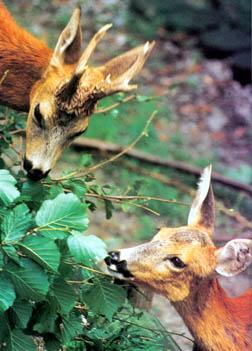 | Roe deer feed on the leaves of a shrub. This deer
is the smallest hoofed animal of the forest. It is also the most
adaptable and widespread. It is even found in small villages and
cultivated fields. The roe deer often enters gardens, and it is
sometimes seen on paved roads. It has adapted well to the conditions of
the modern world. |
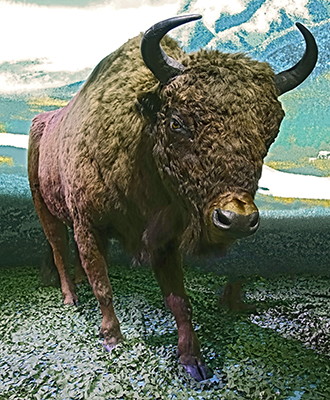
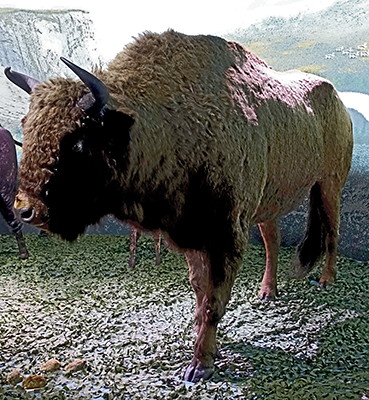
European bison.
Photo: Don Hitchcock 2018
Source: Reconstruction, Musée de l'Homme, Paris
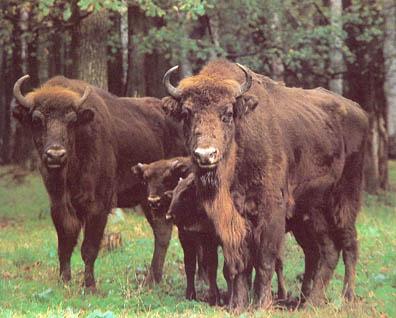
The last wisents (European bison) living in the wild
in the forest of Bialowieza were killed by hungry soldiers during the
Russian Revolution and World War 1. Luckily, several wisents remained
in the various zoos throughout the world. These animals were able to
reproduce in captivity. The zoos carefully selected the animals to be
mated, avoiding blood relationships that were too close (otherwise the
offspring would have been less healthy). As a result of this breeding
program, there are now over two thousand wisents in the world. They are
found mainly in Poland and the Soviet Union, and they are exported to
various countries.
Photo and text: Bottoni et al, 'Central Europe'
| A fully-grown Red Stag can stand 120cm (48") high at
the shoulder and can weigh anything up to 190kg (420lbs). Mature stags
carry a large rack of antlers, which are in peak condition in the early
autumn for the rut, when they are used for bouts of sparring between
rivals. A dominant animal may have 18-20 points (tines) on the antlers,
although 14-16 is more common. The females (hinds) are smaller, with a
shoulder height up to 110cm (44"), and a weight of up to 110kg
(240lbs). |
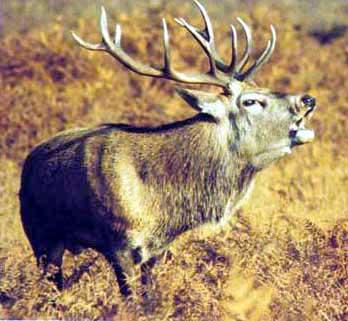 |
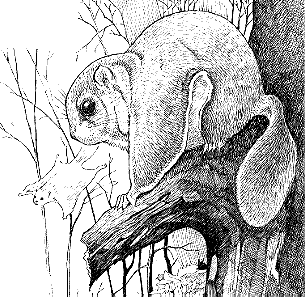
The following pair of animals,the southern mammoth and the hippopotamus, ranged over western Europe from the close of the Pliocene to the middle of the third interglacial, and were hunted by the early Neanderthals and their predecessors. They are associated in western Europe in the third interglacial with flints of Pre-Chellean, Chellean, and early Acheulian age.
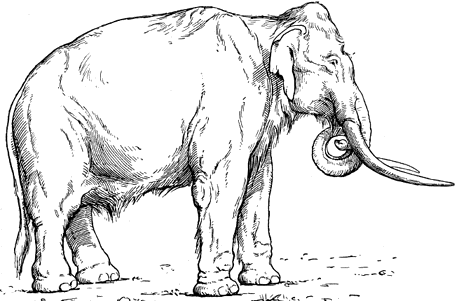
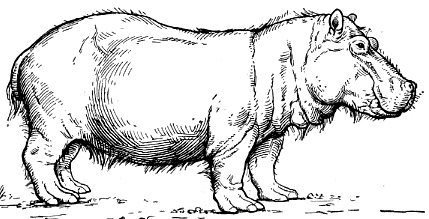
The following pair of animals (the broad nosed or Merck's rhinoceros, and the straight tusked or ancient elephant) replaced the pair above and were hunted by the Neanderthals, but not by Cro Magnon man. By the time that modern man appeared on the scene, these hardy large African-Asiatic mammals had been replaced by the woolly mammoth and the wooly rhinoceros.
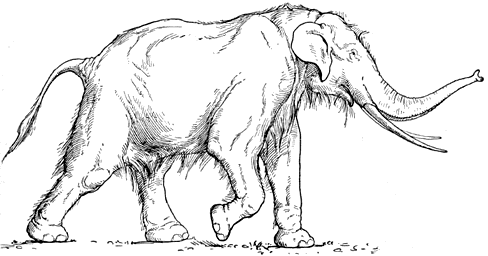
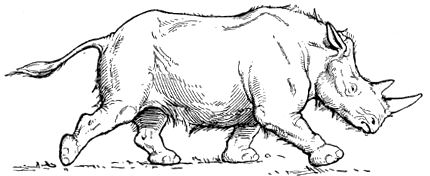
As the last great ice age (the fourth, or Wurm) began, the advancing ice of the Wurm glaciation forced tundra animals further south into western europe. The increasingly cold conditions altered the vegetation as well. The spruce, fir, and arctic willow were now found only in the more sheltered river valleys, while the rest of the landscape was mostly deforested. Animals from as far east as the Obi River on the eastern side of the Ural Mountains in present day Russia migrated into western europe, specifically the obi lemming. Once again the pair of large herbivores were replaced, this time by the woolly mammoth and the woolly rhinoceros.
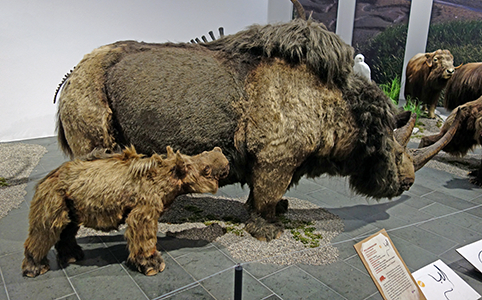
Woolly Rhinoceros, Coelodonta antiquitatis
The adults had a weight of between 1.5 to 2.9 tons. and a maximum lifespan of 35 years.
They ate grasses, and the cows and calves presumably lived in small groups, while the bulls were solitary. The females had 1 calf at a time, with a gestation period circa 15-18 months. Because of finds from the permafrost of Siberia, and Palaeolithic cave art, we have an accurate picture of the appearance of these animals. The horns degraded easily in soil and are therefore preserved only in permafrost. The front horn is flattened on the front and was used as a snow shovel.
The woolly rhinoceros did not reach the extreme northeast of Eurasia and thus did not cross via the Bering Strait to North America. It died out at the end of the last ice age.
Photo: Ralph Frenken 2019
Source and text: Museum Wiesbaden
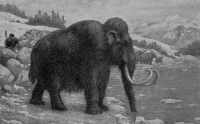
The woolly
mammoth Elephas primagenius
Photo: H.
Osborn, 'Men of the Old Stone Age' (1916)
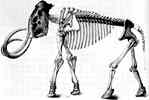
Skeleton of a mammoth reconstructed from bones found in various caves in France.
Photo : Man before History by John Waechter

Dr Len Hills by mammoth tracks revealed in the St. Mary's Reservoir, southern Alberta, in 1999.
By an extraordinary quirk of geological fate, sediments from St Mary's Reservoir in southern Alberta have preserved a rich array of bones and footprints from Alberta's Ice Age: mammoth, musk-ox, horse, caribou, camel and giant bison. Some are more than 11,000 years old.
From: http://www.pma.edmonton.ab.ca/events/timetrav/vii/_tracks.htm
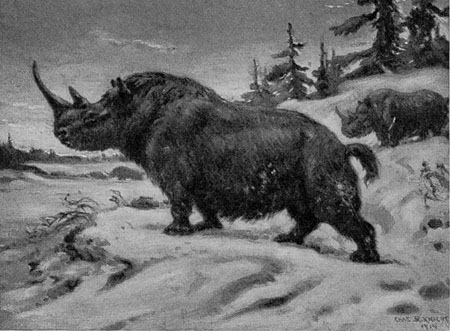
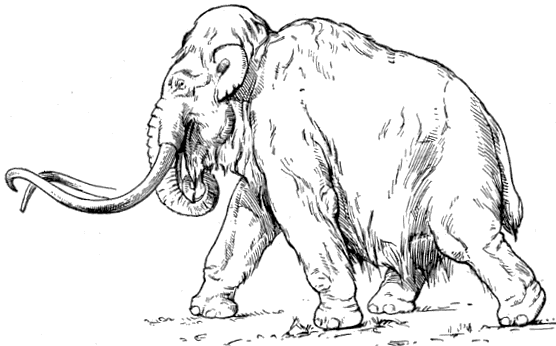
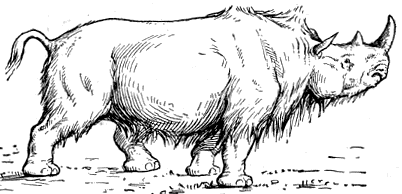
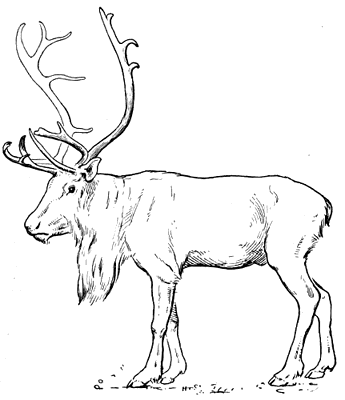
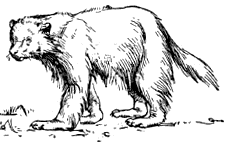
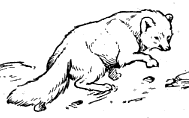

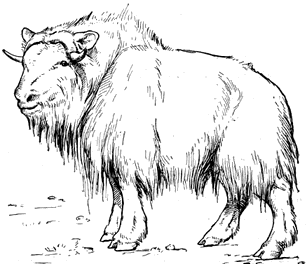
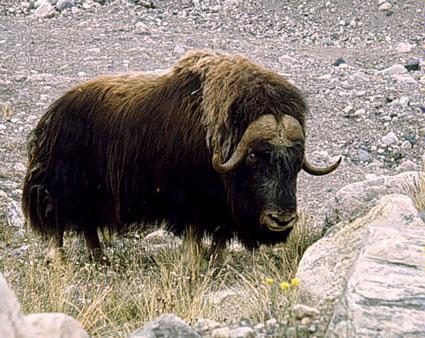
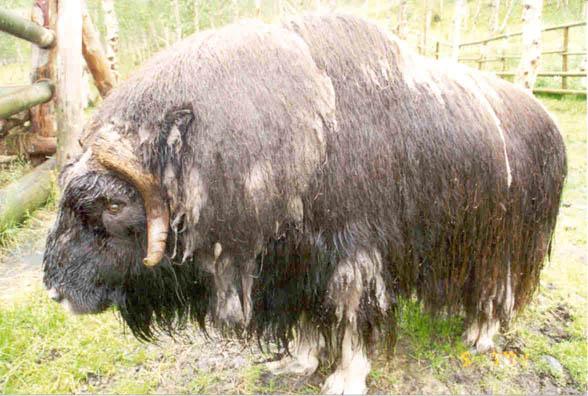

Modern descendants of the four principal types of the horse family which roamed over western Europe in Upper Paleolithic times.
(A) the plateau, desert or Celtic horse
(B) the steppe or Przwalski horse
(C) the forest or Nordic horse
(D) the kiang or wild ass of the Asiatic steppes

This is a rare shot of a Przwalski mare with foal.
Photo from http://museums.ncl.ac.uk/flint/images/horse.jpg
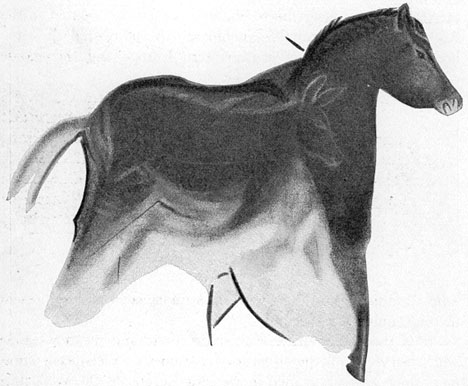


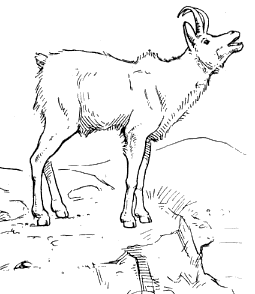
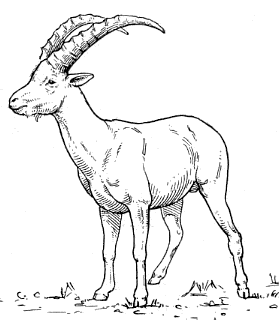
If you are in any doubt about the abilities of ibex to negotiate steep slopes, these photos below should lay those doubts to rest.
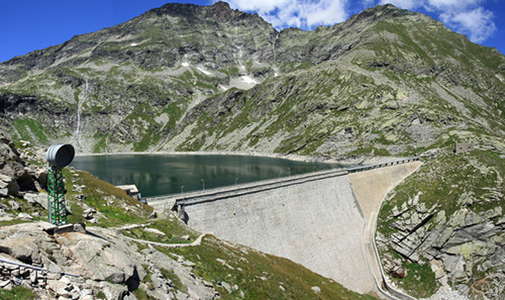
This is the Diga del Cingino dam in Italy - can you see the little dots on the wall?
What do you think they are?
Photo and text: viral email
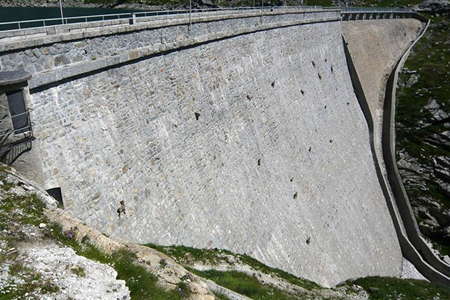
Look even closer. Still don't know what they are?
Photo and text: viral email
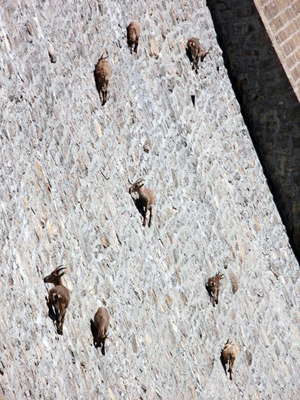
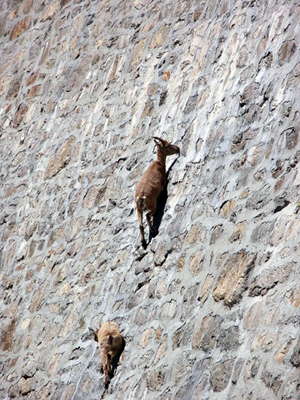
Let's take an even closer look. They are European Ibex.
Photo and text: viral email
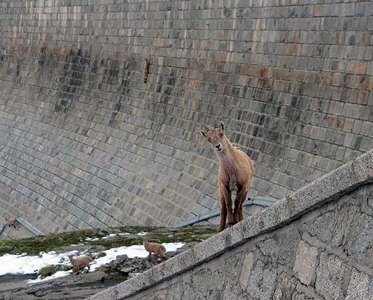
They like to eat the moss & lichen, and lick the salt off the dam wall.
Photo and text: viral email
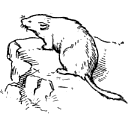

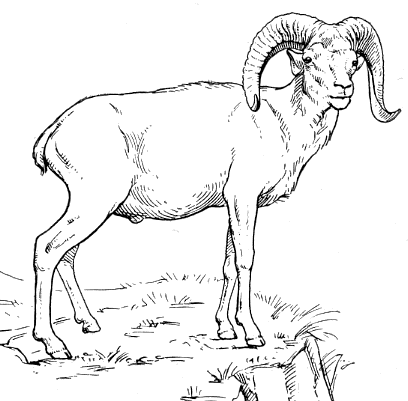
Steppe animals from the steppes and deserts of Asia, (particularly Ukraine) which invaded western Europe in Upper Palaeolithic times, first in the late Acheulian times, and fully represented by Magdalenian times.
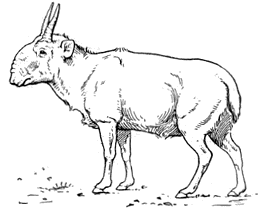
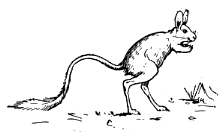

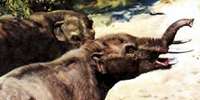 Coming originally from Africa, the mastodons invaded Europe and Asia 18 million years ago. They made their way to North America via the Bering Bridge 10 million years ago and finally reached South America two million years ago, after the isthmus of Panama was formed roughly three million years ago, an event that made the recent ice ages possible. The development of the tusks and of the trunk reflects the evolution of the mastodons during the Miocene, which lasted from 23 million years ago to 5 million years BP.
Coming originally from Africa, the mastodons invaded Europe and Asia 18 million years ago. They made their way to North America via the Bering Bridge 10 million years ago and finally reached South America two million years ago, after the isthmus of Panama was formed roughly three million years ago, an event that made the recent ice ages possible. The development of the tusks and of the trunk reflects the evolution of the mastodons during the Miocene, which lasted from 23 million years ago to 5 million years BP.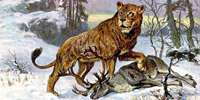 The cave lion is known from Paleolithic cave paintings, ivory carvings, and clay figurines. These representations indicate that cave lions had rounded, protruding ears, tufted tails, possibly faint tiger-like stripes, and that at least some had a ruff or primitive mane around their neck, indicating males. The cave lion received its common name because large quantities of its remains are found in caves, but it is doubtful whether they lived in them. They probably preferred conifer forests and grasslands, where medium-sized to large herbivores occurred.
The cave lion is known from Paleolithic cave paintings, ivory carvings, and clay figurines. These representations indicate that cave lions had rounded, protruding ears, tufted tails, possibly faint tiger-like stripes, and that at least some had a ruff or primitive mane around their neck, indicating males. The cave lion received its common name because large quantities of its remains are found in caves, but it is doubtful whether they lived in them. They probably preferred conifer forests and grasslands, where medium-sized to large herbivores occurred. 